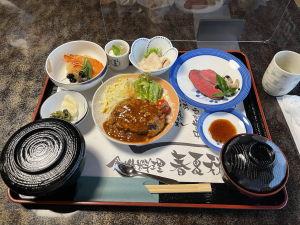Table Manners

Dining in Japan is an experience that transcends the mere act of eating. It's a cultural tapestry woven with intricate etiquette, unspoken rules, and a deep respect for both the food and the company you share it with. Navigating this etiquette can seem daunting for foreign visitors, but understanding these traditions will not only enhance your dining experience but also show respect to your Japanese hosts.[1]
Respecting the Ritual
At the heart of Japanese dining lies a deep respect for food and the shared experience. This manifests in subtle gestures, like bowing before and after a meal, expressing gratitude for the nourishment received. Meals are often occasions for communal harmony, so avoid dominating conversations or hogging dishes. Let the flow of conversation and food weave its magic, savoring each morsel with mindfulness.
Before the Meal
A clean slate is essential for any meal. While oshibori (wet towels) are provided, they are meant for wiping your hands before and after the meal, not for cleaning dishes or utensils.
Before digging in, express gratitude by placing your hands together in front of your chest and bowing slightly. This simple gesture of "itadakimasu" (I humbly receive) shows appreciation for the food and the effort put into preparing it.
Mastering the Chopsticks
Chopsticks, the elegant tools of Japanese gastronomy, require a touch of practice. Remember, they are not for spearing or digging, but for gently picking up morsels. Avoid resting them vertically in your bowl, a symbol of offering to the deceased. When passing dishes, use the ends meant for your own mouth, never the center section. Mastering these nuances demonstrates awareness and respect for the cultural significance of these simple tools.[2]
During the Meal
Slurping or making audible noises while eating may seem impolite in many cultures, but in Japan, it's a sign of appreciation for the deliciousness of the food. Embrace the "zu-zu" of noodle slurping and the gentle "oishii" (delicious) sighs, for they add to the symphony of shared enjoyment. However, avoid excessively loud noises or belching, maintaining a balance between appreciation and decorum.
Mixing side dishes with rice is generally not recommended in Japanese dining etiquette. Japanese cuisine emphasizes the beauty and individuality of each dish. Each element on your plate, from the vibrant sashimi to the delicate pickles, is carefully chosen and arranged to create a harmonious balance of flavors and textures. Mixing them together can disrupt this artistic presentation and diminish the unique qualities of each component. Of course, some dishes, like donburi (rice bowls with toppings), are exception since they are specifically meant to be mixed together.
Emptying your rice bowl signifies that you enjoyed the meal and are satisfied. Leaving rice uneaten can be seen as wasteful and impolite.
After the Meal
When finished, express your gratitude again by saying "gokyochiiso sama deshita" (It was a delicious meal). Use the oshibori to wipe your bowl and utensils before returning them.
Traditionally, the person who initiated the outing settles the bill. However, offering to contribute or taking turns paying is becoming more common, especially among friends.
Beyond the Basics
Respect the food culture: While you may not be familiar with a particular dish, expressing disapproval can be seen as impolite, especially when others are enjoying it with enthusiasm.
Respect the host: Let your host order or suggest dishes if unfamiliar with the menu. Show appreciation for their hospitality and follow their lead when unsure about etiquette.
Mindful communication: Avoid loud conversations or using your phone at the table. Focus on enjoying the company and the meal.
Dress code: While casual attire is acceptable in most restaurants, avoid overly revealing or disrespectful clothing. A neat and tidy appearance is always appreciated.
Additional Points
Bowing: Bowing is a common way to express respect and gratitude in Japanese culture. A slight bow of the head is sufficient when greeting or thanking someone.
Shoes off: Always remove your shoes before entering a Japanese home or restaurant. This is a sign of respect for the cleanliness of the space.
Refusing food: It's okay to politely decline food if you're not hungry or have allergies. Simply say "sumimasen, mō yoroshii desu" (No, thank you, I'm full).
Conclusion
Dining etiquette is not about strict rules, but about showing respect and consideration for your hosts and the cultural context. By understanding and practicing these basic guidelines, you can ensure a smooth and enjoyable dining experience in Japan, leaving a lasting impression of cultural appreciation and respect. By embracing these traditions and showing respect for the Japanese way of dining, you'll not only have a memorable culinary experience but also gain a deeper appreciation for the rich culture and customs of this fascinating country.
